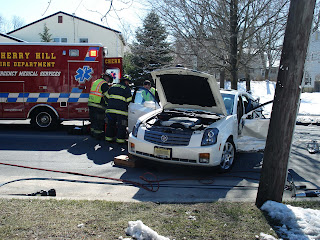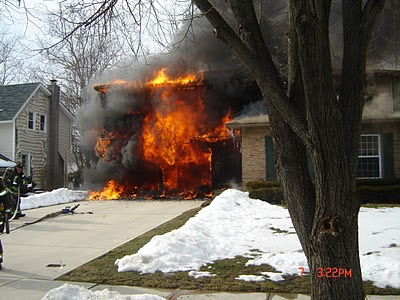At 1254 hours, Squad 13 and BLS 1396 were dispatched to a motor vehicle accident in the area of 330 Browning Lane. Once on location, it was determined that they had a two vehicle accident with one driver entrapped. Rescue 13 and Battalion 13 were added to the assignment. Squad 13 and BLS 1396 began a simultaneous effort to provide patient care while engaging extrication operations. Patient was freed from the vehicle prior to the arrival of the Rescue.
As the Squad Company was wrapping up, County Communications advised of another Motor Vehicle Accident at the intersection of Route 561 and Walt Whitman with a report of people trapped which automatically added Rescue 13 and Battalion 13. Squad 13 quickly redirected their efforts to the response and arrived to find an additional two vehicle crash with one driver still trapped. Captain Haldeman advised county of the conditions and added additional medical resources due to the fact that they had two Priority 2 patients.(2 BLS and 2 ALS units total) Squad 13's crew split up and began patient care and extrication operations. Rescue 13 arrived and aided in the operations, completing the total extrication in about 15 minutes.
Live Camden County Fire & EMS Dispatch
Friday, February 25, 2011
02/23/2011 Back to Back Cut Jobs in Squad 13's 1st due!
Monday, February 7, 2011
Cherry Hill Firefighters Battle House Fire
At approximately 1425 hours on Monday afternoon Cherry Hill Firefighters were alerted to a report of a house fire in the 400 block of Downs Drive. Squad 13, Squrt 1331, Ladder 1344, and Battalion 13, along with a BLS unit responded on the initial alarm. Battalion 13 upgraded the assignment to a working fire dispatch adding Ladder 1324, with a visible column of smoke from Station 3.
Three companies were on the scene with in five minutes of dispatch and found a single family dwelling with fire on the first and second floor. The fire was extending rapidly into the attic and threatening the neighbor’s home. Squad 13's crew deployed a 2 1/2" hand line and initiated an attack on the main body of fire in the two car garage. Battalion 13 assumed command and Squrt 1331's crew deployed a 1 3/4" hose line to the second floor and the two engine companies moved inside to extinguish the fire.
 companies, and 3 chief officers responded to the scene.
companies, and 3 chief officers responded to the scene.
Three companies were on the scene with in five minutes of dispatch and found a single family dwelling with fire on the first and second floor. The fire was extending rapidly into the attic and threatening the neighbor’s home. Squad 13's crew deployed a 2 1/2" hand line and initiated an attack on the main body of fire in the two car garage. Battalion 13 assumed command and Squrt 1331's crew deployed a 1 3/4" hose line to the second floor and the two engine companies moved inside to extinguish the fire.
Ladder 1344 and 1324 conducted a primary search with negative results and initiate ventilation of the dwelling. Members opened up walls and ceilings to assist the engine companies with extinguishing the fire in the attic space. Engine 1322 was special called into the scene as a rapid intervention crew.
Mutual aid from Lawnside, Haddonfield, and Maple Shade provided coverage for Cherry Hill Fire stations. The fire was place under control with in 25 minutes. No injuries were reported. A total of 3 engine companies, 2 ladder  companies, and 3 chief officers responded to the scene.
companies, and 3 chief officers responded to the scene.
Members Train for Ice Rescue Emergencies
Members of Rescue 13 and Ladder 24 spent their Sunday morning reviewing and training on ice rescue operations. The crews practiced rescuing simulated victims from the water. Ice rescue operations require quick action from our personnel to have a successful outcome. Victims exposed to water hovering around the freezing mark will begin to suffer from hypothermia in minutes. Human body heat is lost 25 times faster in water than when exposed to air and death can occur in as little as 15 minutes.
Our members must first be prepared to take care of themselves. Members dressed in exposure suites can operate on the ice and in the water with limited exposure to the cold. Here the rescuers review basic self rescue techniques for getting themselves back up on the surface of the ice after entering the water.
The crews then spent time reviewing the use of the ice rescue sling to remove a victim from the water. It is important that the members are proficient with the equipment and how to deploy it rapidly. A victim in the water may only have a few minutes left after our arrival before they succumb to hypothermia.
The goal of the is that once the rescuer reaches the victim they will gain positive control of the victim and not lose contact with them. Once in the sling the victim is attached to the retrieval line and pulled back to shore with the rescuer.
The companies finished up the training by reviewing shore based rescue using a hose inflation kit and two lengths of 2 1/2" hose. It is important for the first due companies to have a knowledge of what actions they can take to help stabilize the patient and keep them buoyant until the arrival of the rescue company.
Even if the victim can't be removed using the inflated hose the added buoyancy can help keep them above the water until a rescuer can reach them. The hose also provides a large object that is easier for the victim to hold onto as they lose dexterity in their hand from the exposure to the cold water.
 |
| Members practice getting back on top of the ice after entering the water |
Our members must first be prepared to take care of themselves. Members dressed in exposure suites can operate on the ice and in the water with limited exposure to the cold. Here the rescuers review basic self rescue techniques for getting themselves back up on the surface of the ice after entering the water.
The crews then spent time reviewing the use of the ice rescue sling to remove a victim from the water. It is important that the members are proficient with the equipment and how to deploy it rapidly. A victim in the water may only have a few minutes left after our arrival before they succumb to hypothermia.
The goal of the is that once the rescuer reaches the victim they will gain positive control of the victim and not lose contact with them. Once in the sling the victim is attached to the retrieval line and pulled back to shore with the rescuer.
The companies finished up the training by reviewing shore based rescue using a hose inflation kit and two lengths of 2 1/2" hose. It is important for the first due companies to have a knowledge of what actions they can take to help stabilize the patient and keep them buoyant until the arrival of the rescue company.
 |
| Firefighters practice placing a victim in the ice rescue sling |
A Group conducts large area search training.
On January 29th A Group companies trained on Large Area
Search tactics. Each scenario was based on finding an engine
 company firefighter who was separated from the hose line and became lost in a large warehouse type setting. A rapid intervention team was used to locate the victim using Large Area Search rope and procedures. When each victim was found, life sustaining measures were put in place such as assessing the victim, providing air, packaging and removal. The drill was done in zero visibility.
company firefighter who was separated from the hose line and became lost in a large warehouse type setting. A rapid intervention team was used to locate the victim using Large Area Search rope and procedures. When each victim was found, life sustaining measures were put in place such as assessing the victim, providing air, packaging and removal. The drill was done in zero visibility. Discussion following the training included tactical considerations about tools and equipment and search rope placement. Although not used often, it is critical to perform Large Area Search effectively. This type of training keeps members skills sharp for when it is truly needed.
Subscribe to:
Comments (Atom)










